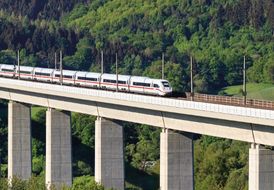Passenger transport
ANTICIPATED MARKET DEVELOPMENT / % | 2021 | 2022 |
German passenger transport (based on pkm) | +4.4 | +8.0 |
As of February 2022. Forecast for 2022 rounded to half percentage points.
Compared to pre-Covid-19 levels, performance fell in 2020 and 2021 as a result of Covid-19. However, the German passenger transport market is expected to recover significantly in 2022. Nevertheless, volume sold in all sectors, with the exception of private motorized transport, will remain below pre-Covid-19 levels on an annual basis. The trend in demand for transport services depends heavily on occurrence of infection, regulatory measures and associated mobility patterns. Community and business travel are being replaced by remote working and digital communication to a noticeable, but probably modest, extent. Individual forms of transport where there is a low risk of infection – traveling by car, bicycle or on foot, for example – should benefit from the ongoing Covid-19 pandemic compared to public transport.
- Under these circumstances, private motorized transport in particular is likely to reach pre-Covid-19 levels. Rising fuel prices, partly as a result of the CO₂ pricing that entered into force in 2021, will initially remain of minor importance. Further significant increases in 2022 as a result of the war in Ukraine will dampen the increase and favor the shifts in the mode of transport to rail.
- Domestic German air transport is facing a lengthy recovery in view of subdued demand due to Covid-19 control measures, climate change policies and a steep drop in supply. In 2022, it will only make up for some of the losses sustained as a result of Covid-19.
- Public road passenger transport is expected to increase again, but will continue to suffer from substitution effects from cars and bicycles in local transport. Long-distance bus services are expected to grow more slowly in comparison due to the reduced supply and strong competi-tion from rail passenger transport.
- A noticeable recovery in local and long-distance transport is expected for rail passenger transport. Long-distance transport is likely to benefit from gains from air and long-distance bus transport, as well as an improved service offering. The main premises for this development are a decline in infection numbers, the loosening or lifting of restrictions related to Covid-19, and increasing confidence in public transport, as well as the desire for a shift in the mode of transport.
Also in European passenger transport, the development will be specific to the mode of transport and will vary from region to region. Financial weaknesses and strategic realignment of individual providers make it probable that the mobility market will undergo consolidation. However, the progressive climate policy of the EU and its member states remains the long-term motor for the development of climate-friendly public mobility – and therefore rail passenger transport in particular.



